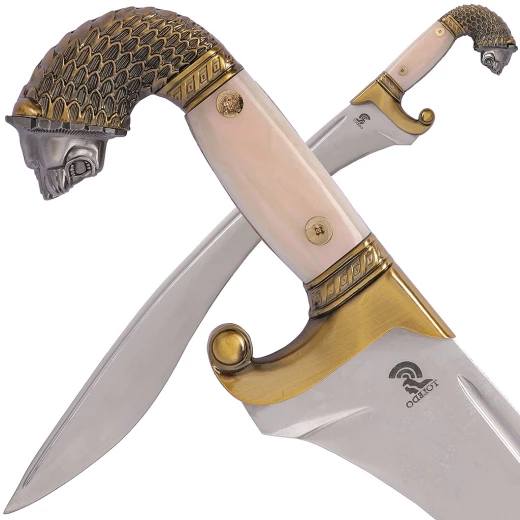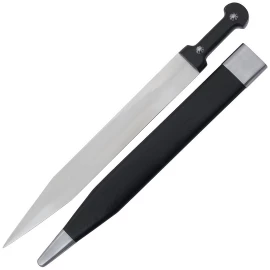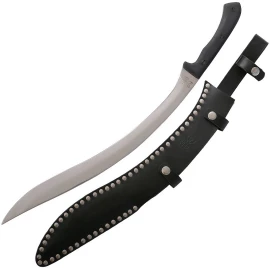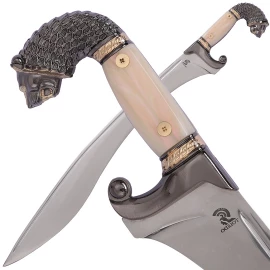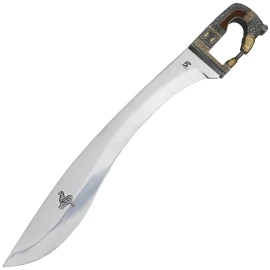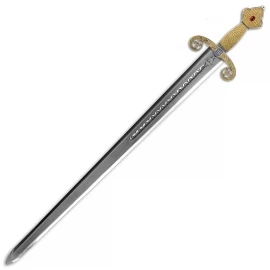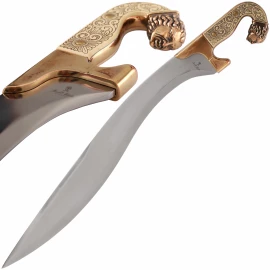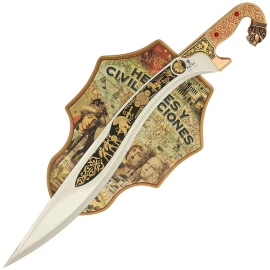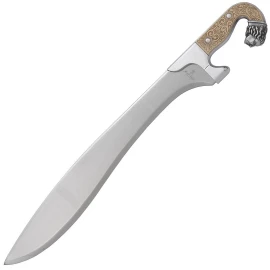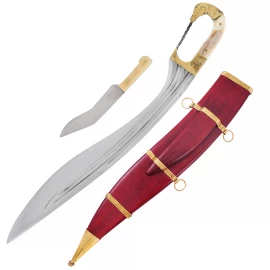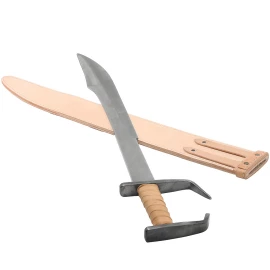Greek-Macedonian Kopis with brass hilt
Notify me when the item is in stock.
We will inform you as soon as we stock up.
Greek-Macedonian Kopis with brass hilt
Please note: This is just an ornamental item, not intended for real use!
- Blade made of 440 stainless steel quenched and tempered to 47-51 HRC
- Total length approx. 743mm
- Blade length approx. 598mm
- Length of the guard approx. 83mm
- Width of the blade at parry approx. 59.58mm
- Width of the blade at the widest point approx. 72.66mm
- Thickness of the blade approx. 3.95mm
- Weight approx. 1398 g
All dimensions are approximate and may vary slightly from piece to piece. Delivery without sheath or stand.
Top branded quality, made by Art Gladius®. Made in Toledo (Spain), in the city with centuries-long traditional of blacksmithing, sword-making and other ancient crafts.
Greek-Macedonian Kopis
This bladed weapon is sometimes incorrectly referred to as a "Falcata". Even in this officer's version (which is directly associated with Alexander of Macedon for commercial reasons) it is very different from the "Falcata". The "falcata" was the typical sword of the Iberian tribes in Hispania, recognised by the Romans during the first battles with the Carthaginian Barca in northern Hispania in the third century BC, and advanced further east during the Second Punic War with the Iberian mercenaries of Hannibal's Carthaginian army as it crossed the Alps into Italy. It was an Iberian infantry weapon, had a longer blade (kopis only 60-80 cm long, this kopis is at the lower limit with a length of 598 mm) and a double-edged point, it was much more suitable for stabbing.
In contrast, the "Kopis" was a typical cavalry weapon, and Xenophon already recommended cavalrymen to use it instead of the short straight sword "Xiphos", as the heavy blade also dealt terrible blows and could be used to stab during a cavalry skirmish and close combat (which was not the main purpose, the main effect was to slash: see the famous scene from the battle of Granicus in May 334 BC, Alexander, who was in a cavalryman's armour in the middle of the battle). Alexander, who was attacked by Persian satraps in an equestrian battle, had his life saved at the last moment by the commander of his bodyguard, Cleitus the Black, Alexander was shaken by a blow from the satrap Resax on his helmet, and Cleitus cut off the arm and sword of the satrap Spitridates, who was already wielding a scythe at the king's back). The Greek and especially the Macedonian milieu never adopted the "falcata", nor did the Romans (for them the "gladius hispanicus", which was also used by the cavalry, was perfectly adequate, just think of the battle of Pydna on 22 June 168 BC, The description of the wounds of the phalanx was astonishing: the whole shoulder and right arm severed, heads and lower limbs cut off clean off, etc.). ).
The greatest expert, Giuseppe Cascarino, clearly shows the difference between a "Kopis" and a "Falcata" in Figures 2.46 (a Kopis found in Alalia, Corsica) and 2.47 (a Falcata from the Iberian necropolis of Almenedilla); the additional images are attached for comparison. Giuseppe CASCARINO, L'Esercito romano. Armamento e organizzazione, vol. I. Dalle origini alla fine della Repubblica, Rimini, Il Cerchio Srl, second edition 2010, ISBN 88-8474-146-7, p. 60).
Similarly, both contemporary depictions and professional reconstruction drawings always show Alexander of Macedon with a 'Kopis', never with a 'Falcata', which the Macedonians really did not use.
Write to our specialist


